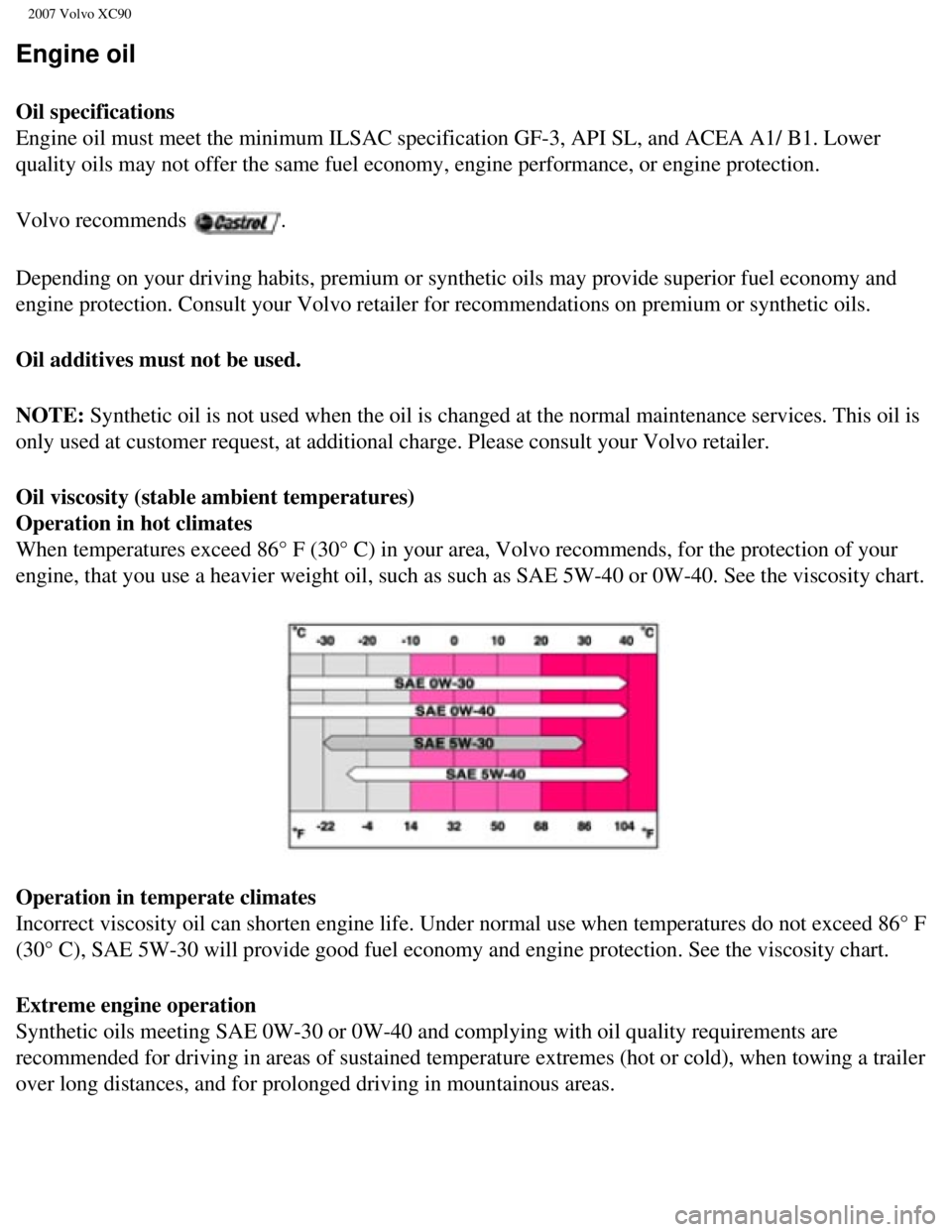2007 VOLVO XC90 fuel
[x] Cancel search: fuelPage 152 of 268

2007 Volvo XC90
W - Winter/Wet driving mode - enhanced vehicle traction
l Mode W will only function if the gear selector is in the (D)rive position.
l Press the button at the base of the gear selector to engage/disengage th\
is driving mode.
l An LED in the button will light up to indicate that W is engaged and thi\
s will also be displayed in the instrument panel
(see
page 46).
l This mode may be selected for starting/ moving off on slippery roads.
1. Synthetic oil is not used when the oil is changed at the normal maint\
enance service intervals except at owner request and at
additional charge. Please consult your Volvo retailer.
pg. 144 Starting and driving
Before a long distance trip
It is always worthwhile to have your vehicle checked at a Volvo retailer\
before driving long distances. Your retailer will
also be able to supply you with bulbs, fuses, spark plugs and wiper blad\
es for your use in the event that problems occur.
As a minimum, the following items should be checked before any long trip\
:
l Check that engine runs smoothly and that fuel consumption is normal.
l Check for fuel, oil, and fluid leakage.
l Check transmission oil level1.
l Check condition of drive belts.
l Check state of the battery's charge.
l Examine tires carefully (the spare tire as well), and replace those th\
at are worn. Check tire pressures.
l The brakes, front wheel alignment, and steering gear should be checked b\
y your Volvo retailer only.
l Check all lights, including high beams.
l Reflective warning triangles are legally required in some states/provinc\
es.
l Have a word with your Volvo retailer if you intend to drive in countries\
where it may be difficult to obtain the correct
fuel.
l Consider your destination. If you will be driving through an area where \
snow or ice are likely to occur, consider snow
tires.
1. To prevent injury from contact with hot surfaces, do not inspect your\
vehicle's transmission fluid yourself. Have your vehicle's
transmission fluid level inspected by a qualified Volvo service technici\
an.
pg. 145 Starting and driving
Blind Spot Information System (BLIS) - option
file:///K|/ownersdocs/2007/2007_XC90/07xc90_06.htm (28 of 32)12/30/200\
6 5:53:44 PM
Page 157 of 268

2007 Volvo XC90
2 0 0 7
VOLVO XC90
Wheels and tires
pg. 149 Wheels and tires
General information 150
Tire inflation pressure tables - U.S. models
154
Tire inflation pressure tables - Canadian models
155
Tire Pressure Monitoring System (TPMS) -
option
156
Tire designations
159
Glossary of tire terminology
160
Vehicle loading
161
Uniform Tire Quality Grading
163
Snow chains, snow tires, studded tires
164
Temporary spare
165
Changing wheels
166
pg. 150 Wheels and tires
General information
Your vehicle is equipped with tires according to the vehicle's tire info\
rmation placard on the B-pillar
(the structural member at the side of the vehicle, at the rear of the d\
river's door opening), or on the inside
of the fuel filler door on Canadian models.
The tires have good road holding characteristics and offer good handling\
on dry and wet surfaces. It
should be noted however that the tires have been developed to give these\
features on snow/ice-free
surfaces.
Certain models are equipped with "all-season" tires, which provide a som\
ewhat higher degree of road
holding on slippery surfaces than tires without the "all-season" rating.\
However, for optimum road
file:///K|/ownersdocs/2007/2007_XC90/07xc90_07.htm (1 of 23)12/30/2006\
5:53:47 PM
Page 164 of 268

2007 Volvo XC90
Each tire, including the spare (if provided), should be checked monthl\
y when cold and inflated to the
inflation pressure recommended by the vehicle manufacturer on the vehicl\
e placard or tire inflation
pressure label. (If your vehicle has tires of a different size than the\
size indicated on the vehicle placard
or tire inflation pressure label, you should determine the proper tire i\
nflation pressure for those tires.)
As an added safety feature, your vehicle has been equipped with a tire p\
ressure monitoring system
(TPMS) that illuminates a low tire pressure telltale when one or more \
of your tires is significantly under-
inflated. Accordingly, when the low tire pressure telltale illuminates, \
you should stop and check your
tires as soon as possible, and inflate them to the proper pressure. Driv\
ing on a significantly under-
inflated tire causes the tire to overheat and can lead to tire failure. \
Under-inflation also reduces fuel
efficiency and tire tread life, and may affect the vehicle's handling an\
d stopping ability.
Please note that the TPMS is not a substitute for proper tire maintenanc\
e, and it is the driver's
responsibility to maintain correct tire pressure, even if under-inflatio\
n has not reached the level to trigger
illumination of the TPMS low tire pressure telltale.
Your vehicle has also been equipped with a TPMS malfunction indicator to\
indicate when the system is
not operating properly. The TPMS malfunction indicator is combined with \
the low tire pressure telltale.
When the system detects a malfunction, the telltale will flash for appro\
ximately one minute and then
remain continuously illuminated. This sequence will continue upon subseq\
uent vehicle start-ups as long
as the malfunction exists. When the malfunction indicator is illuminated\
, the system may not be able to
detect or signal low tire pressure as intended. TPMS malfunctions may oc\
cur for a variety of reasons,
including the installation of replacement or alternate tires or wheels o\
n the vehicle that prevent the
TPMS from functioning properly. Always check the TPMS malfunction tellta\
le after replacing one or
more tires or wheels on your vehicle to ensure that the replacement or a\
lternate tires and wheels allow
the TPMS to continue to function properly.
NOTE:
l TPMS indicates low tire pressure but does not replace normal tire mainte\
nance. For information on
correct tire pressure, please refer to the table on
page 154, or consult your Volvo retailer.
Erasing warning messages
When a low tire pressure warning message has been displayed, and the tir\
e pressure warning light has
come on:
pg. 157 Wheels and tires
Tire Pressure Monitoring System (TPMS) - option
- Use a tire pressure gauge to check the inflation pressure of all four \
tires.
- Re-inflate the tire(s) to the correct pressure (consult the tire pr\
essure placard or the table on
page 154).
file:///K|/ownersdocs/2007/2007_XC90/07xc90_07.htm (8 of 23)12/30/2006\
5:53:47 PM
Page 167 of 268

2007 Volvo XC90
the wider the tire.
2. 65: The ratio of the tire's height to its width.
3. R: Radial tire.
4. 15: The diameter of the wheel rim (in inches).
5. 95: The tire's load index. In this example, a load index of 95 equals\
a maximum load of 1521 lbs (690
kg).
6. H: The tire's speed rating, or the maximum speed at which the tire is\
designed to be driven for
extended periods of time, carrying a permissible load for the vehicle, a\
nd with correct inflation pressure.
For example, H indicates a speed rating of 130 mph (210 km/h).
NOTE: This information may not appear on the tire because it is not required \
by law.
7. M+S or M/S = Mud and Snow, AT = All Terrain, AS = All Season
8. U.S. DOT Tire Identification Number (TIN): This begins with the let\
ters "DOT" and indicates that the
tire meets all federal standards. The next two numbers or letters are th\
e plant code where it was
manufactured, the next two are the tire size code and the last four numb\
ers represent the week and year
the tire was built. For example, the numbers 317 mean the 31st week of 1\
997. After 2000 the numbers
go to four digits. For example, 2501 means the 25th week of 2001. The nu\
mbers in between are
marketing codes used at the manufacturer's discretion. This information \
helps a tire manufacturer
identify a tire for safety recall purposes.
9. Tire Ply Composition and Material Used: Indicates the number of plies\
indicates or the number of
layers of rubber-coated fabric in the tire tread and sidewall. Tire manu\
facturers also must indicate the
ply materials in the tire and the sidewall, which include steel, nylon, \
polyester, and others.
10. Maximum Load: Indicates the maximum load in pounds and kilograms tha\
t can be carried by the
tire. Refer to the vehicle's tire information placard or the safety cert\
ification label, located on the B-Pillar
or the driver's door or on the inside of the fuel filler door on Canadia\
n models, for the correct tire
pressure for your vehicle.
11. Treadwear, Traction, and Temperature grades: See
page 163 for more information.
12. Maximum permissible inflation pressure: the greatest amount of air p\
ressure that should ever be put
in the tire. This limit is set by the tire manufacturer.
Tire suppliers may have additional markings, notes or warnings such as s\
tandard load, radial tubeless,
etc.
file:///K|/ownersdocs/2007/2007_XC90/07xc90_07.htm (11 of 23)12/30/200\
6 5:53:47 PM
Page 168 of 268

2007 Volvo XC90
pg. 160 Wheels and tires
Glossary of tire terminology
l Tire information placard: A placard showing the OE (Original Equipment) tire sizes, recommende\
d
inflation pressure, and the maximum weight the vehicle can carry.
l Tire Identification Number (TIN): A number on the sidewall of each tire providing information
about the tire brand and manufacturing plant, tire size and date of manu\
facturer.
l Inflation pressure: A measure of the amount of air in a tire.
l Standard load: A class of P-metric or Metric tires designed to carry a maximum load a\
t 35 psi [37
psi (2.5 bar) for Metric tires]. Increasing the inflation pressure bey\
ond this pressure will not increase the
tires load carrying capability.
l Extra load: A class of P-metric or Metric tires designed to carry a heavier maximu\
m load at 41 psi
[43 psi (2.9 bar) for Metric tires]. Increasing the inflation pressure\
beyond this pressure will not increase
the tires load carrying capability.
l kPa: Kilopascal, a metric unit of air pressure.
l PSI: Pounds per square inch, a standard unit of air pressure.
l B-pillar: The structural member at the side of the vehicle behind the front door\
.
l Bead area of the tire: Area of the tire next to the rim.
l Sidewall of the tire: Area between the bead area and the tread.
l Tread area of the tire: Area of the perimeter of the tire that contacts the road when mounted \
on the
vehicle.
l Rim: The metal support (wheel) for a tire or a tire and tube assembly upo\
n which the tire beads are
seated.
l Maximum load rating: a figure indicating the maximum load in pounds and kilograms that can \
be
carried by the tire. This rating is established by the tire manufacturer\
.
l Maximum permissible inflation pressure: the greatest amount of air pressure that should ever be
put in the tire. This limit is set by the tire manufacturer.
l Recommended tire inflation pressure: inflation pressure, established by Volvo, which is based on
the type of tires that are mounted on a vehicle at the factory. This inf\
lation pressure is affected by the
number of occupants in the vehicle, the amount of cargo, and the speed a\
t which the vehicle will be
driven for a prolonged period. This information can be found on the tire\
inflation placard(s) located on
the driver's side B-pillar or on the inside of the fuel filler door on C\
anadian models, and in the tire
inflation table in this chapter.
l Cold tires: The tires are considered to be cold when they have the same temperatur\
e as the
surrounding (ambient) air. This temperature is normally reached after \
the vehicle has been parked for at
least 3 hours.
pg. 161 Wheels and tires
Vehicle loading
file:///K|/ownersdocs/2007/2007_XC90/07xc90_07.htm (12 of 23)12/30/200\
6 5:53:47 PM
Page 169 of 268

2007 Volvo XC90
Properly loading your vehicle will provide maximum return of vehicle des\
ign performance.
Before loading your vehicle, familiarize yourself with the following ter\
ms for determining your vehicle's
weight ratings, with or without a trailer, from the vehicle's Federal/ C\
anadian Motor Vehicle Safety
Standards (FMVSS/CMVSS) label, and the vehicle's tire information plac\
ard.
Curb weight
The weight of the vehicle including a full tank of fuel and all standard\
equipment. It does not include
passengers, cargo, or optional equipment.
Capacity weight
All weight added to the curb weight, including cargo and optional equipm\
ent. When towing, trailer hitch
tongue load is also part of cargo weight.
NOTE: For trailer towing information, please refer to the section "Towing a t\
railer" on
page 137.
Permissible axle weight
The maximum allowable weight that can be carried by a single axle (fron\
t or rear). These numbers are
shown on the Federal/Canadian Motor Vehicle Safety Standards (FMVSS/ CM\
VSS) label. The total
load on each axle must never exceed its maximum permissible weight.
Gross vehicle weight (GVW)
The vehicle's curb weight + cargo + passengers.
NOTE:
l The location of the various labels in your vehicle can be found on page 208.
l A table listing important weight limits for your vehicle can be found on\
page 209.
Steps for Determining Correct Load Limit
- Locate the statement "the combined weight of occupants and cargo shoul\
d never exceed XXX pounds''
on your vehicle's placard.
- Determine the combined weight of the driver and passengers that will b\
e riding in your vehicle.
- Subtract the combined weight of the driver and passengers from XXX kil\
ograms or XXX pounds.
- The resulting figure equals the available amount of cargo and luggage \
load capacity. For example, if
the "XXX'' amount equals 1400 lbs. and there will be five 150 lb. passen\
gers in your vehicle, the amount
of available cargo and luggage load capacity is 650 lbs. (1400- 750 (5\
x 150) = 650 lbs.)
- Determine the combined weight of luggage and cargo being loaded on the\
vehicle. That weight may
not safely exceed the available cargo and luggage load capacity calculat\
ed in Step 4.
- If your vehicle will be towing a trailer, load from your trailer will \
be transferred to your vehicle.
Consult this manual
1 to determine how this reduces the available cargo and luggage load capa\
city of
your vehicle.
file:///K|/ownersdocs/2007/2007_XC90/07xc90_07.htm (13 of 23)12/30/200\
6 5:53:47 PM
Page 189 of 268

2007 Volvo XC90
pg. 181 Maintenance
Maintaining your car
Owner maintenance
Periodic maintenance requirements and intervals are described in your ve\
hicle's Warranty and Service
Records Information booklet.
The following points can be carried out between the normally scheduled m\
aintenance services.
Each time the vehicle is refueled:
l Check the engine oil level
l Clean the windshield, windshield wipers, headlights, and tail lights
Monthly:
l Check cold tire pressure in all tires. Inspect the tires for wear.
l Check that engine coolant and other fluid levels are between the indicat\
ed "min" and "max" markings.
l Clean interior glass surfaces with a glass cleaner and soft paper towels\
.
l Wipe driver information displays with a soft cloth.
l Visually inspect battery terminals for corrosion. Corrosion may indicate\
a loose terminal connector, or
a battery near the end of its useful service life. Consult your Volvo re\
tailer for additional information.
As needed:
l Wash the vehicle, including the undercarriage, to reduce wear that can b\
e caused by a buildup of dirt,
and corrosion that can be caused by salt residues.
l Clean leaves and twigs from air intake vents at the base of the windshie\
ld, and from other places
where they may collect.
NOTE: Complete service information for qualified technicians is available onl\
ine for purchase or
subscription at
www.volvotechinfo.com.
pg. 182 Maintenance
Emission inspection readiness
What is an Onboard Diagnostic System (OBD II)?
OBD II is part of your vehicle's computerized engine management system. \
It stores diagnostic
information about your vehicle's emission controls. It can light the Che\
ck Engine light (MIL) if it detects
an emission control "fault." A "fault" is a component or system that is \
not performing within an expected
range. A fault may be permanent or temporary. OBD II will store a messag\
e about any fault.
file:///K|/ownersdocs/2007/2007_XC90/07xc90_09.htm (3 of 37)12/30/2006\
5:53:50 PM
Page 194 of 268

2007 Volvo XC90
Engine oil
Oil specifications
Engine oil must meet the minimum ILSAC specification GF-3, API SL, and A\
CEA A1/ B1. Lower
quality oils may not offer the same fuel economy, engine performance, or\
engine protection.
Volvo recommends
.
Depending on your driving habits, premium or synthetic oils may provide \
superior fuel economy and
engine protection. Consult your Volvo retailer for recommendations on pr\
emium or synthetic oils.
Oil additives must not be used.
NOTE: Synthetic oil is not used when the oil is changed at the normal mainten\
ance services. This oil is
only used at customer request, at additional charge. Please consult your\
Volvo retailer.
Oil viscosity (stable ambient temperatures)
Operation in hot climates
When temperatures exceed 86° F (30° C) in your area, Volvo recom\
mends, for the protection of your
engine, that you use a heavier weight oil, such as such as SAE 5W-40 or \
0W-40. See the viscosity chart.
Operation in temperate climates
Incorrect viscosity oil can shorten engine life. Under normal use when t\
emperatures do not exceed 86° F
(30° C), SAE 5W-30 will provide good fuel economy and engine protec\
tion. See the viscosity chart.
Extreme engine operation
Synthetic oils meeting SAE 0W-30 or 0W-40 and complying with oil quality\
requirements are
recommended for driving in areas of sustained temperature extremes (hot\
or cold), when towing a trailer
over long distances, and for prolonged driving in mountainous areas.
file:///K|/ownersdocs/2007/2007_XC90/07xc90_09.htm (8 of 37)12/30/2006\
5:53:50 PM